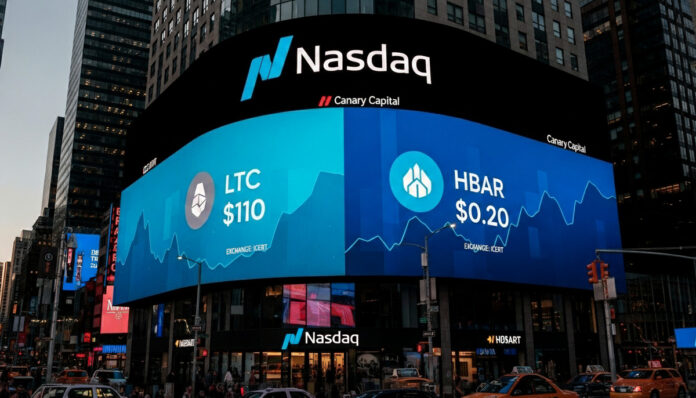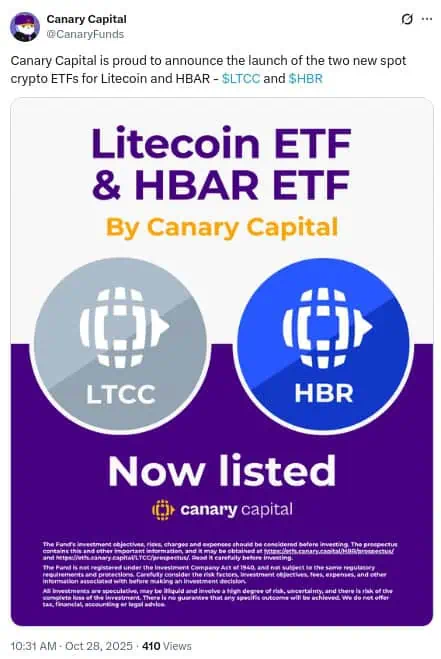
Two new cryptocurrency funds could begin trading on the regulated market tomorrow, expanding institutional investment in crypto beyond Bitcoin and Ethereum.
The halls of regulated finance will welcome two new digital tenants. Investment manager Canary Capital confirmed that its funds linked to Litecoin (LTC) y ivy (HBAR) will begin their official listing on the Nasdaq.
The listing and opening of these two investment funds marks a new phase in the integration of digital assets into traditional large-cap portfolios, demonstrating that institutional interest is steadily expanding beyond the familiar boundaries of Bitcoin and Ethereum.
The news, confirmed by the company in an official statement, stands out in a complex environment. The launch comes amid a partial government shutdown In the United States, regulatory activity has been frozen, and therefore the Securities and Exchange Commission's (SEC) expected ruling on the numerous altcoin ETF applications that have been on hold for months. However, the financial machinery seems to have found an operational path immune to the political turmoil in Washington. This progress is not due to new legislation, but to the SEC's clarification of a technical procedure.
As reported by this media, the agency issued recent guidelines that fine-tuning the S-1 registration processSpecifically, it cleared the way for companies to submit their applications without a dilatory amendment, allowing registration to automatically take effect after a 20-day period. According to sources close to the process, Canary Capital activated its funds by submitting the 8-A forms needed on Monday, consolidating the debut of their products Canary Litecoin ETF y Canary HBAR ETF.
Litecoin and Hedera ETFs are coming. Join Bit2Me now.ETFs break down barriers to crypto investing
The digital asset industry and regulators have found a working rhythm that survives the current uncertainty. Canary Capital's ability to navigate the registration process during a government shutdown illustrates a structural shift: the integration of these assets no longer depends on grand political gestures, but rather on technical execution and compliance with clear regulations.
Steven McClurg, the firm's CEO and founder, called the launch a "historic moment" and another milestone in a pivotal year for the industry.
This mission, shared by several firms, depends on the ETF structure. These funds act as a simultaneous translator between two worlds. They allow institutional and retail investors to gain exposure to the performance of digital assets using the vehicles they already know and in the markets where they already operate. As the firm's own analysis points out, this format eliminates the need to directly manage tokens, reducing the operational and custodial barriers that have kept much of the traditional capital out.

Diversification and technology beyond Bitcoin
The cryptocurrency market has undergone a significant transformation since the early approvals of Bitcoin and Ethereum-based funds in 2024. Today, the focus of institutional investors has broadened, and the next wave is not focused on a single asset, but rather on a more diverse portfolio that includes technologies with different approaches and fundamentals.
Litecoin, one of the oldest and most established networks in the digital ecosystem, represents the original thesis of peer-to-peer payments, designed as a more agile and lightweight version of Bitcoin's architecture. Its inclusion validates the thesis that networks with a long history and a clear use case, such as efficient transactions, have a place in the new economy.
Hedera, on the other hand, represents a different technological bet. Its HBAR token powers a public network that does not use a traditional blockchain, but the Hashgraph consensus algorithmThis technology is known in development circles for its high speed and secure transaction validation. Its arrival in regulated markets suggests that institutional investors are not only seeking "digital gold," but also exposure to the high-performance infrastructure of the future.
Ready for new crypto ETFs? Trade LTC and HBAR hereThe US market embraces public networks
Canary Capital isn't alone in this push. The SEC's procedural clarity has opened the door to a wave of applications that were already in the pipeline. A report by The Block, published the same day as Canary's confirmation, indicated that the SEC was ready to greenlight a significant number of applications.
These include those from other major firms in the sector, such as Grayscale, which is also reportedly moving forward with its own launches. In particular, the Grayscale Solana Trust ETF begins operating this week. The inclusion of Solana, another network known for its high performance, confirms the trend of how regulated capital is ready for the next generation of public networks.
This synchronized shift toward alternative assets cements the US market as an increasingly structured environment for institutional adoption. The cryptocurrency products arriving this week aren't experiments; they're the logical expansion of a new asset class that is being absorbed, piece by piece, into the global financial system.

Main Cryptocurrencies Course
Basic levelBit2Me Academy brings you a new course in which you will learn everything you need about the most important cryptocurrencies that exist today.
Litecoin and Hedera: Cryptocurrency Investments Are Normalized
El debut of Canary Capital's new Litecoin and Hedera funds, expected as soon as tomorrow, October 29, closes a chapter of speculation and opens one of normalized operation.
The narrative is no longer "if" digital assets will enter regulated finance, but "how" and "which." The answer seems to be: through procedurally sound vehicles like ETFs, starting with those assets with the greatest capitalization and technical credibility.
As 2025 continues to advance, the trend points to a continued expansion of these crypto financial products, creating an increasingly detailed investment map of the digital ecosystem.
Bit2Me gives you access to HBAR: buy today


